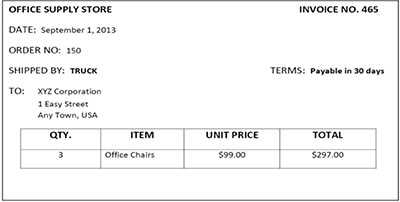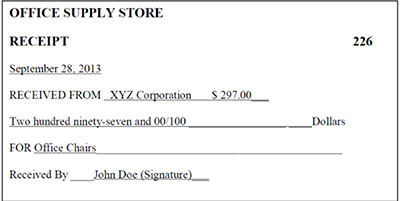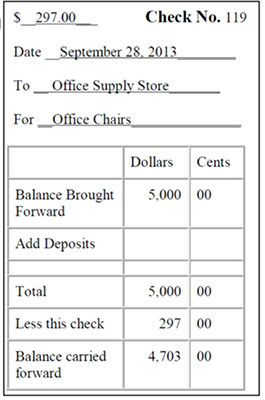Learn
Analyzing Source Documents
In the course of any particular day, a business may pay its rent, place an advertisement, contract to have work done, pay its employees, sell products, purchase new equipment, and so on.
When a business transaction occurs, a paper is prepared describing all the basic facts of the transaction such as the purpose, and date of the transaction. This paper is a source document.
A source document provides evidence that a business transaction has occured. The four common source documents are:
- Invoice (record of cash received)
- Receipt (lists the same information as a check)
- Check Stub (used if no other source document exists)
- Memo (a short written message)
Other source documents include: cash register tapes, employee time cards, and any other evidence of money changing hands. The nature of the transactions determines the type of source document.
Analyzing Source Documents: Invoices

Who was the invoice sent to?
Answer: XYZ Corporation
What is the invoice number?
Answer: 465
What date was the invoice sent?
Answer: September 1, 2013
What was the order number?
Answer: 150
How was the order shipped?
Answer: By truck
What are the terms of payment?
Answer: Payable in 30 days
What items were ordered?
Answer: Office chairs
How many of the items were ordered?
Answer: 3
What was the cost of each item?
Answer: $99.00
What was the total cost of the items?
Answer: $297.00

Analyzing Source Documents: Receipts
Who paid the bill?
Answer: XYZ Corporation
How much was the payment?
Answer: $297.00
What was the receipt number?
Answer: 226
To whose account will the money be deposited?
Answer: Office supply store
On what day was the bill paid?
Answer: September 28, 2013
Who received the payment?
Answer: John Doe
What was the payment for?
Answer: Office chairs

Analyzing Source Documents: Check Stubs
What was the check number?
Answer: 119
When was the check written?
Answer: September 28, 2013
How much was the check for?
Answer: $297.00
Who was the check written to?
Answer: Office supply store
What was the check written for?
Answer: Office chairs
What was the balance before writing the check?
Answer: $5000.00
What is the balance after the check?
Answer: $4,703.00
Handling Source Documents
Now let’s discuss how these three source documents would be handled in the accounting records. XYZ Corporation is purchasing chairs from Office Supply Store. When Office Supply Store sold the chairs, they prepared an invoice showing: what was purchased, price, when it was purchased, when the payment is due, invoice number, and any other pertinent information.
XYZ Corporation purchased the chairs. The invoice that Office Supply Store gave them is their bill to pay. XYZ will pay with a check and this check is proof that the bill is paid. Accounting clerks for both organizations will analyze the source documents and then record the business transactions as a journal entry in the journal. Let’s look at each company and how they handled the source documents:
Handling Invoices - Seller
Remember the invoice that Office Supply Store prepared? This tells the accounting clerk at Office Supply Store that a Sale has been made. It also tells them that the money has not been paid yet, but it is expected to be received within 30 days. How does the accounting clerk know when Office Supply Store should receive the money? Look at the Invoice and the Terms: Payable in 30 days. That tells Office Supply Store they will receive the money later. This is called Accounts Receivable.
Invoice
Office Supply Store
Invoice No. 465
Date: September 1, 2020
Order Number: 150
Shipped By: Truck
Terms: Payable in 60 days
To: XYZ Corporation, 1 Easy Street, Any Town, USA
| Qty. | Item | Unit Price | Total |
|---|---|---|---|
| 3 | Office Chairs | $99.00 | $297.00 |
Accounts Receivable is money that is owed to the business because a customer charged instead of paying at the point of sale. Accounts Receivable is an asset. This business transaction just increased Office Supply Store Accounts Receivable balance.
So what two accounts are affected on the books of Office Supply Store and what will you do to those accounts?
- Accounts Receivable will increase - you will DEBIT
- Sales will increase - you will CREDIT
Handling Receipts - Seller
Let’s continue looking at the Office Supply Store accounting clerk duties. It’s a few weeks later and XYZ Corporation pays their bill. When they pay, Office Supply Store writes a receipt. This receipt proves that the bill is paid and cash was received. Remember, Accounts Receivable means that you will receive money later, well later has arrived, and Office Supply Store has received the money. Now, Accounts Receivable will decrease (because we have now received the money) and cash will increase.
Office Supply Store
Receipt 226
Date: September 26, 2020
Received from: XYZ Corporation
Amount: Two hundred ninety-seven and 00/100 Dollars
For: Office Chairs
Received by: John Doe (Signature)
So what accounts will be affected and how?
- Cash increased - so you will DEBIT
- Accounts Receivable decreased - so you will CREDIT
Handling Invoices - Buyer
Now let’s look at XYZ Corporation, remember they are the buyer. Let’s look at the Invoice again. The accounting clerk for XYZ Corporation will look at this source document and record that equipment have been purchased and that XYZ Corporation owes for the chairs. What accounts will be affected and how?
- Equipment, an asset, will increase - so you will DEBIT
- Accounts Payable, a liability, will increase - so you will CREDIT
Invoice
Office Supply Store
Invoice No. 465
Date: September 1, 2020
Order Number: 150
Shipped By: Truck
Terms: Payable in 60 days
To: XYZ Corporation, 1 Easy Street, Any Town, USA
| Qty. | Item | Unit Price | Total |
|---|---|---|---|
| 3 | Office Chairs | $99.00 | $297.00 |
Handling Check Stubs - Buyer
Let’s look at the check stub indicating XYZ Corporation paid for the chairs. Anytime a check is written, cash is paid. The check is written to pay what is owed.
$297.00 Check No. 119
Date: September 1, 2020
To: Office Supply Store
For: Office Chairs
| Dollars | Cents | |
|---|---|---|
| Balance Brought Forward | 5000 | 00 |
| Add Deposits | ||
| Total | 5000 | 00 |
| Less this check | 297 | 00 |
| Balance Carried Forward | 4703 | 00 |
What accounts will be affected and how?
- Accounts Payable, a liability, will decrease - so you will DEBIT
- Cash, an asset, will decrease - so you will DEBIT
After an accounting entry is made to record the business transactions, all source documents should be properly filed where they can be retrieved if and when they are needed. The process of being able to track a journal entry to its source document is called an audit trail.
Keeping a source document for a business is just like keeping your receipts for personal taxes. You have to keep receipts in case the IRS audits your taxes. The same is true for a business, but a business keeps source documents for every financial transaction.